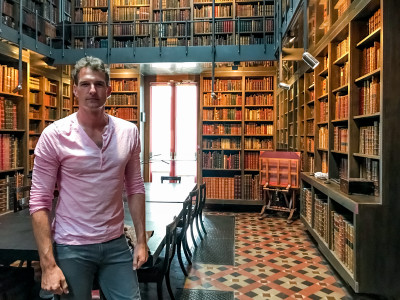
Daniel Maclise RA, Cartoon for 'The Meeting of Wellington and Blücher After the Battle of Waterloo', March 1858- June 1859.
Chalk on paper, on ten separate sheets attached to individual panels. 3372 mm x 13818 mm. © Photo: Royal Academy of Arts, London. Photographer: Prudence Cuming Associates Limited.
This image is not available to download. To licence this image for commercial purposes, contact our Picture Library at picturelibrary@royalacademy.org.uk
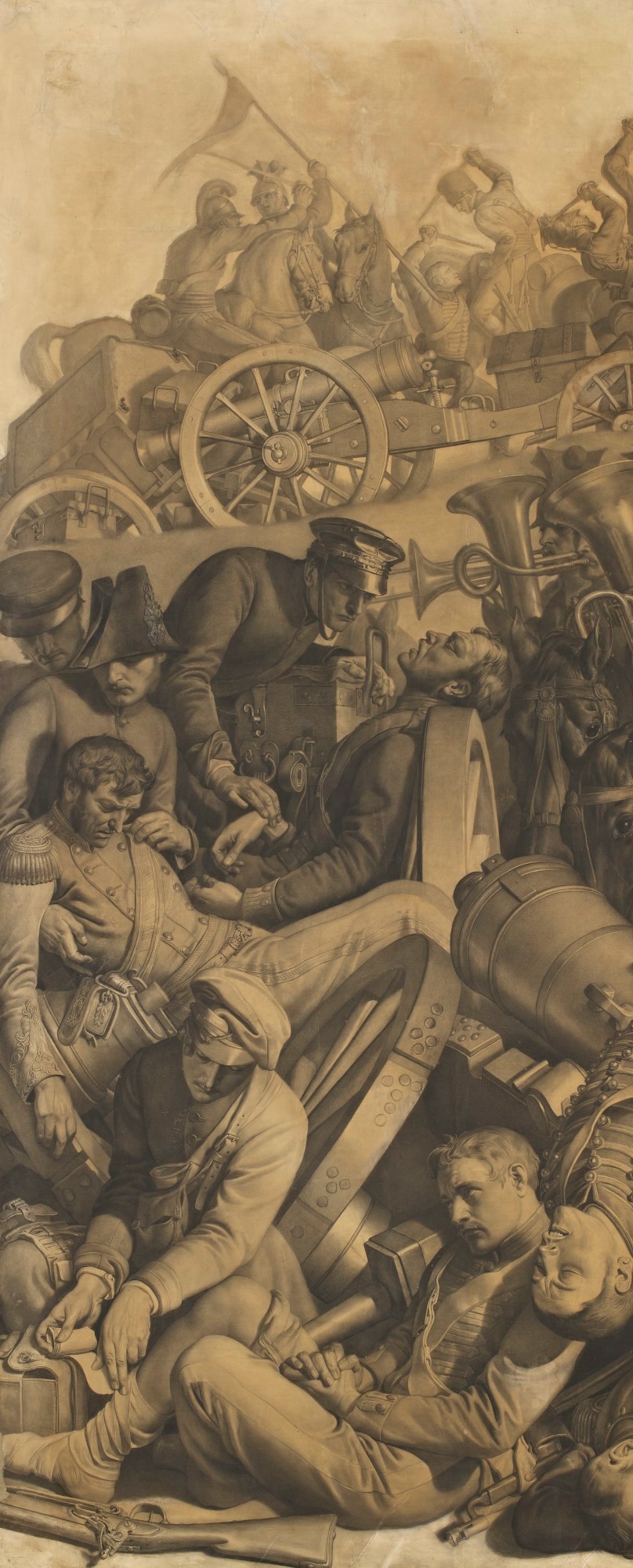
Daniel Maclise RA, Cartoon for 'The Meeting of Wellington and Blücher After the Battle of Waterloo', March 1858- June 1859.
Chalk on paper, on ten separate sheets attached to individual panels. 3372 mm x 13818 mm. © Photo: Royal Academy of Arts, London.
This image is not available to download. To licence this image for commercial purposes, contact our Picture Library at picturelibrary@royalacademy.org.uk
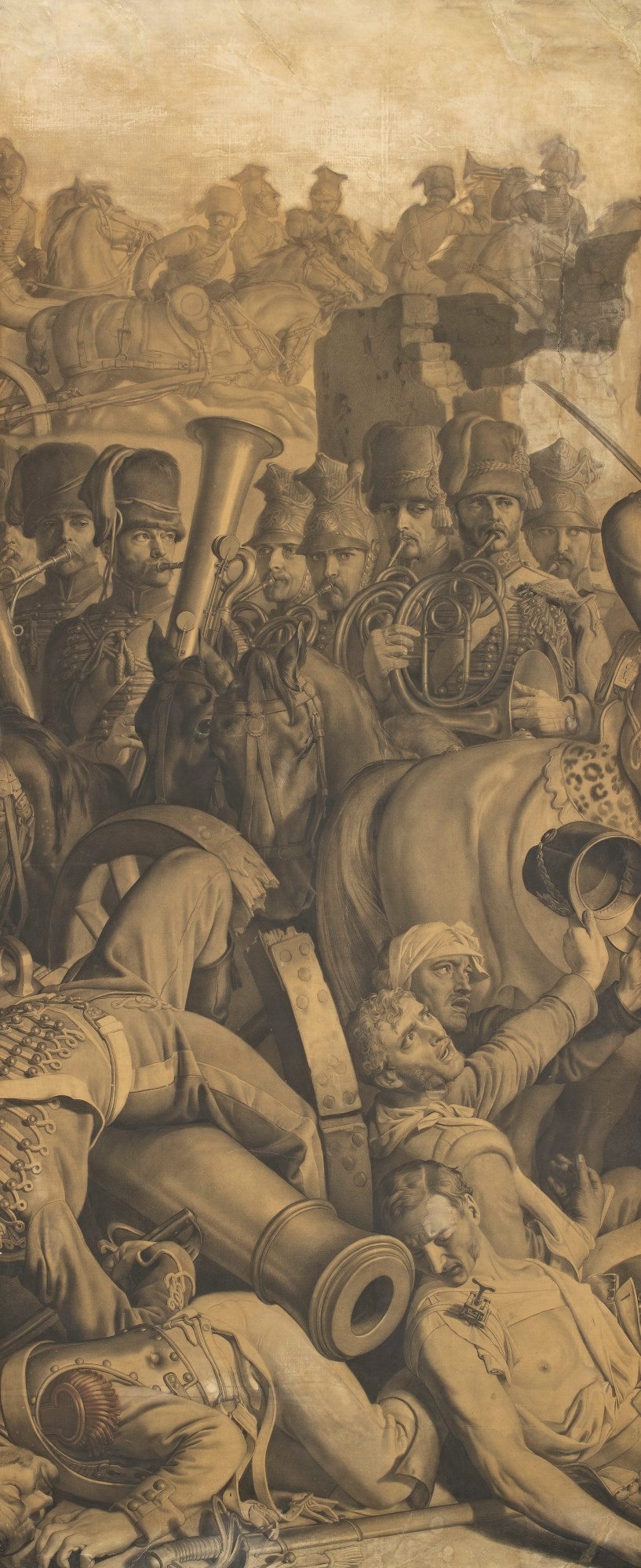
Daniel Maclise RA, Cartoon for 'The Meeting of Wellington and Blücher After the Battle of Waterloo', March 1858- June 1859.
Chalk on paper, on ten separate sheets attached to individual panels. 3372 mm x 13818 mm. © Photo: Royal Academy of Arts, London. Photographer: Prudence Cuming Associates Limited.
This image is not available to download. To licence this image for commercial purposes, contact our Picture Library at picturelibrary@royalacademy.org.uk
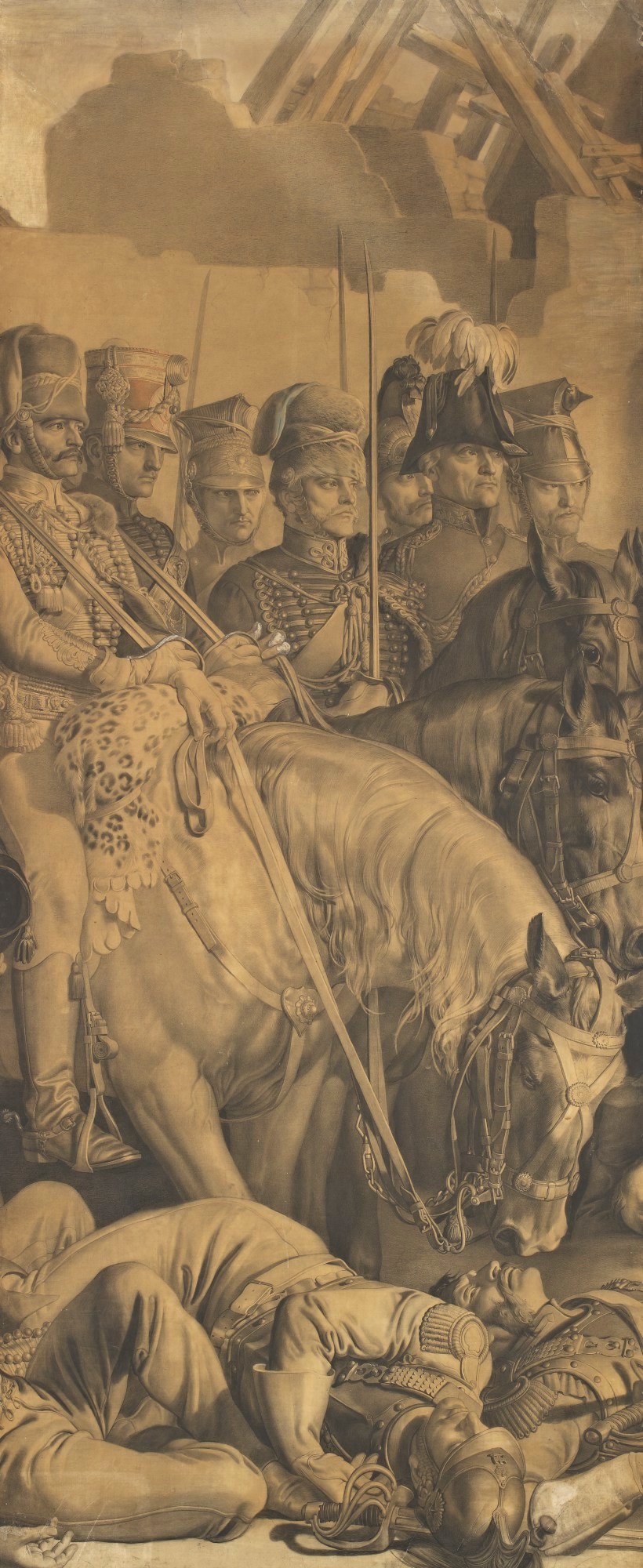
Daniel Maclise RA, Cartoon for 'The Meeting of Wellington and Blücher After the Battle of Waterloo', March 1858- June 1859.
Chalk on paper, on ten separate sheets attached to individual panels. 3372 mm x 13818 mm. © Photo: Royal Academy of Arts, London. Photographer: Prudence Cuming Associates Limited.
This image is not available to download. To licence this image for commercial purposes, contact our Picture Library at picturelibrary@royalacademy.org.uk
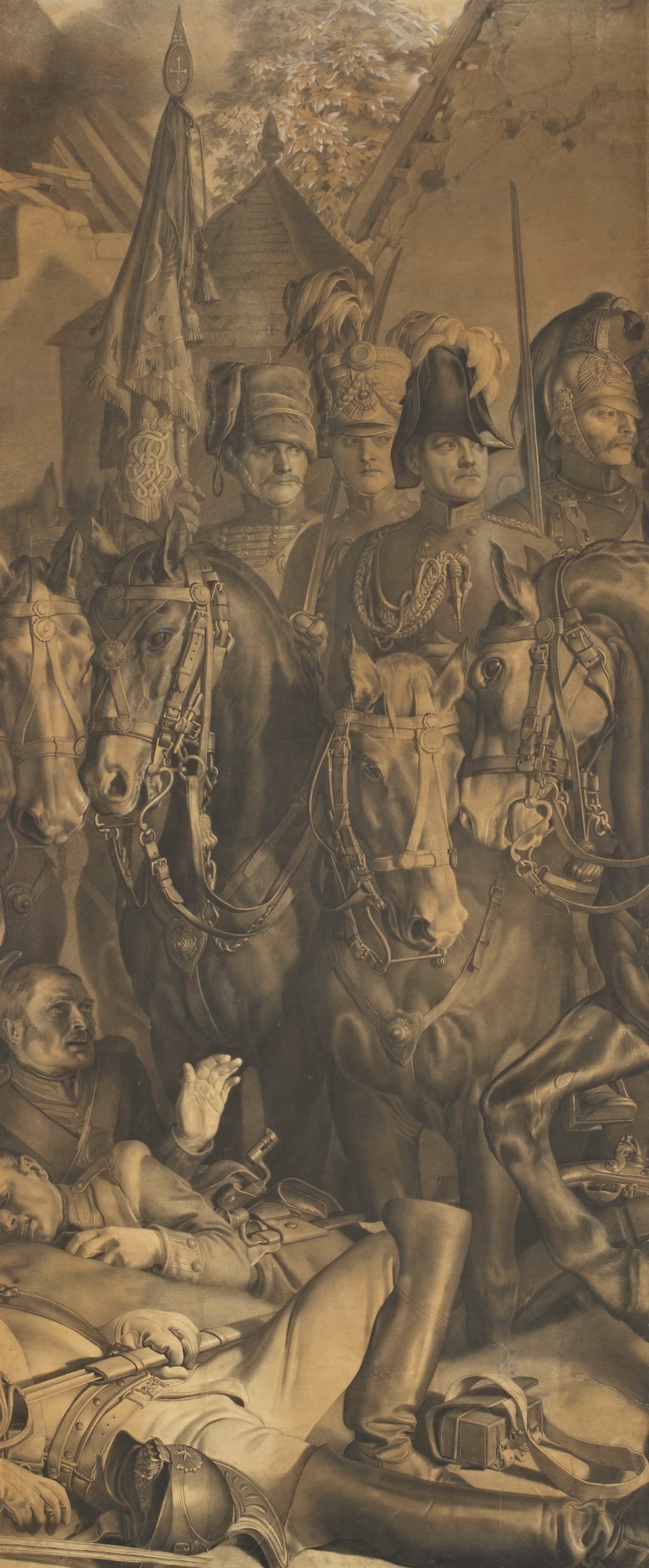
Daniel Maclise RA, Cartoon for 'The Meeting of Wellington and Blücher After the Battle of Waterloo', March 1858- June 1859.
Chalk on paper, on ten separate sheets attached to individual panels. 3372 mm x 13818 mm. © Photo: Royal Academy of Arts, London. Photographer: Prudence Cuming Associates Limited.
This image is not available to download. To licence this image for commercial purposes, contact our Picture Library at picturelibrary@royalacademy.org.uk
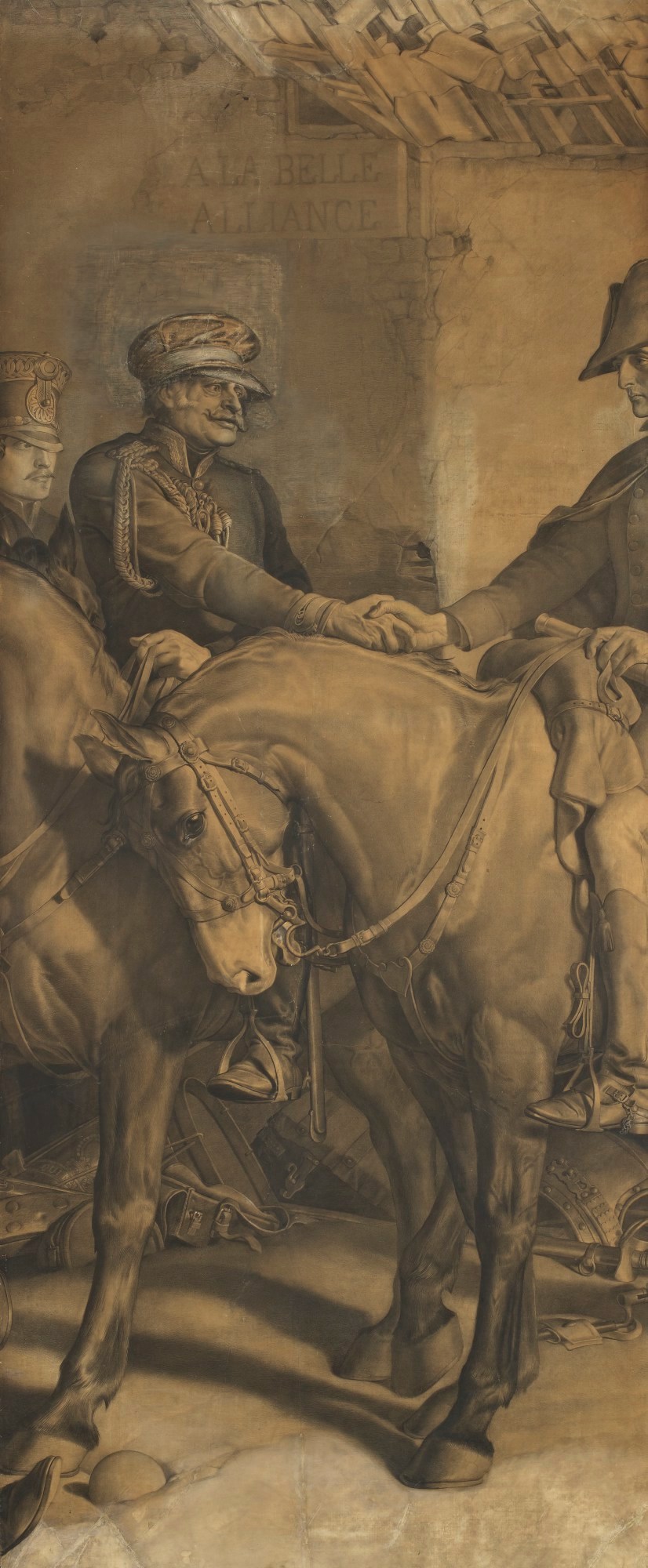
Daniel Maclise RA, Cartoon for 'The Meeting of Wellington and Blücher After the Battle of Waterloo', March 1858- June 1859.
Chalk on paper, on ten separate sheets attached to individual panels. 3372 mm x 13818 mm. © Photo: Royal Academy of Arts, London. Photographer: Prudence Cuming Associates Limited.
This image is not available to download. To licence this image for commercial purposes, contact our Picture Library at picturelibrary@royalacademy.org.uk
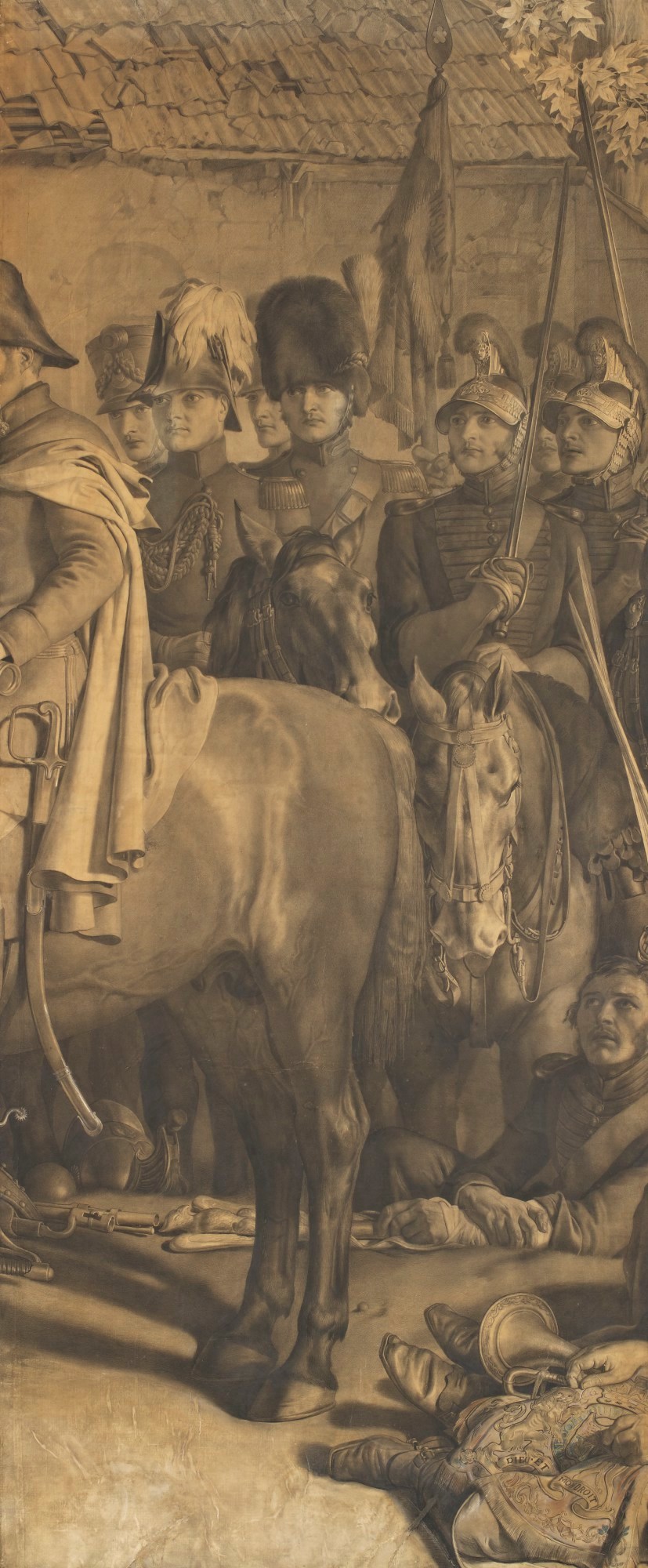
Daniel Maclise RA, Cartoon for 'The Meeting of Wellington and Blücher After the Battle of Waterloo', March 1858- June 1859.
Chalk on paper, on ten separate sheets attached to individual panels. 3372 mm x 13818 mm. © Photo: Royal Academy of Arts, London. Photographer: Prudence Cuming Associates Limited.
This image is not available to download. To licence this image for commercial purposes, contact our Picture Library at picturelibrary@royalacademy.org.uk
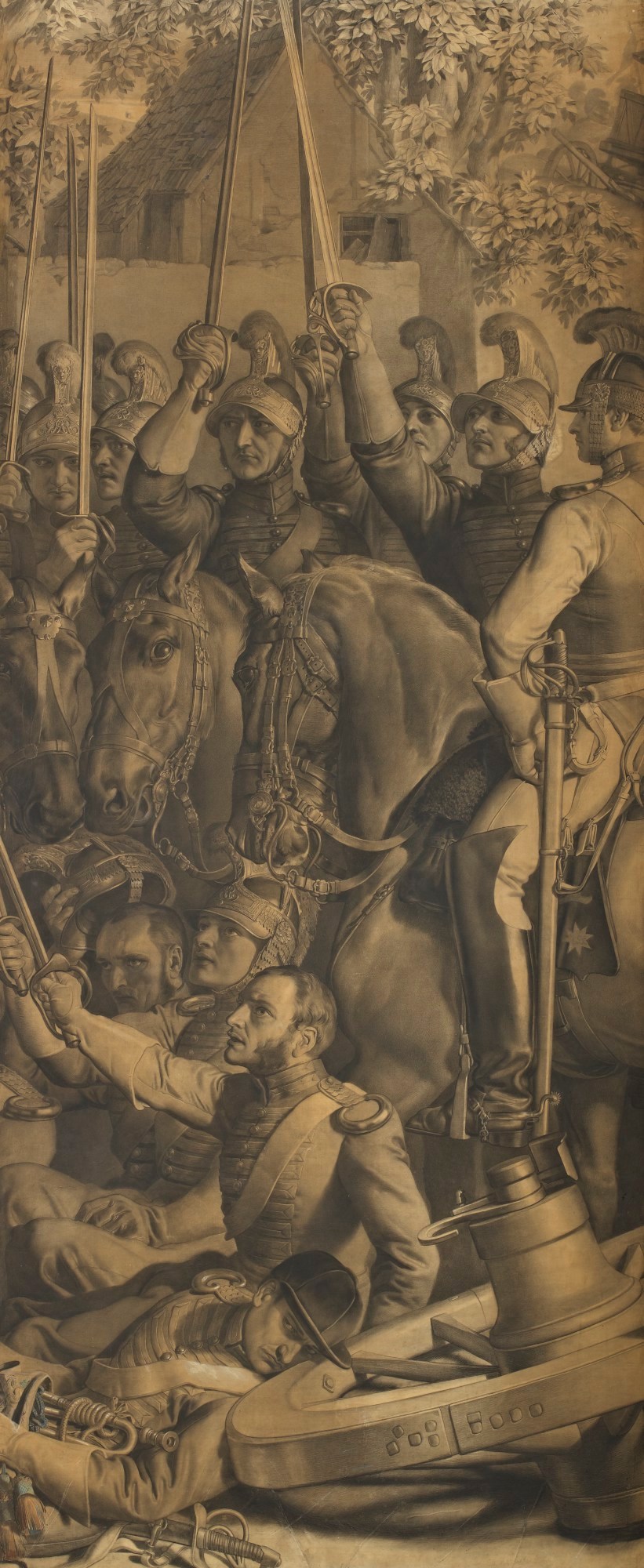
Daniel Maclise RA, Cartoon for 'The Meeting of Wellington and Blücher After the Battle of Waterloo', March 1858- June 1859.
Chalk on paper, on ten separate sheets attached to individual panels. 3372 mm x 13818 mm. © Photo: Royal Academy of Arts, London. Photographer: Prudence Cuming Associates Limited.
This image is not available to download. To licence this image for commercial purposes, contact our Picture Library at picturelibrary@royalacademy.org.uk
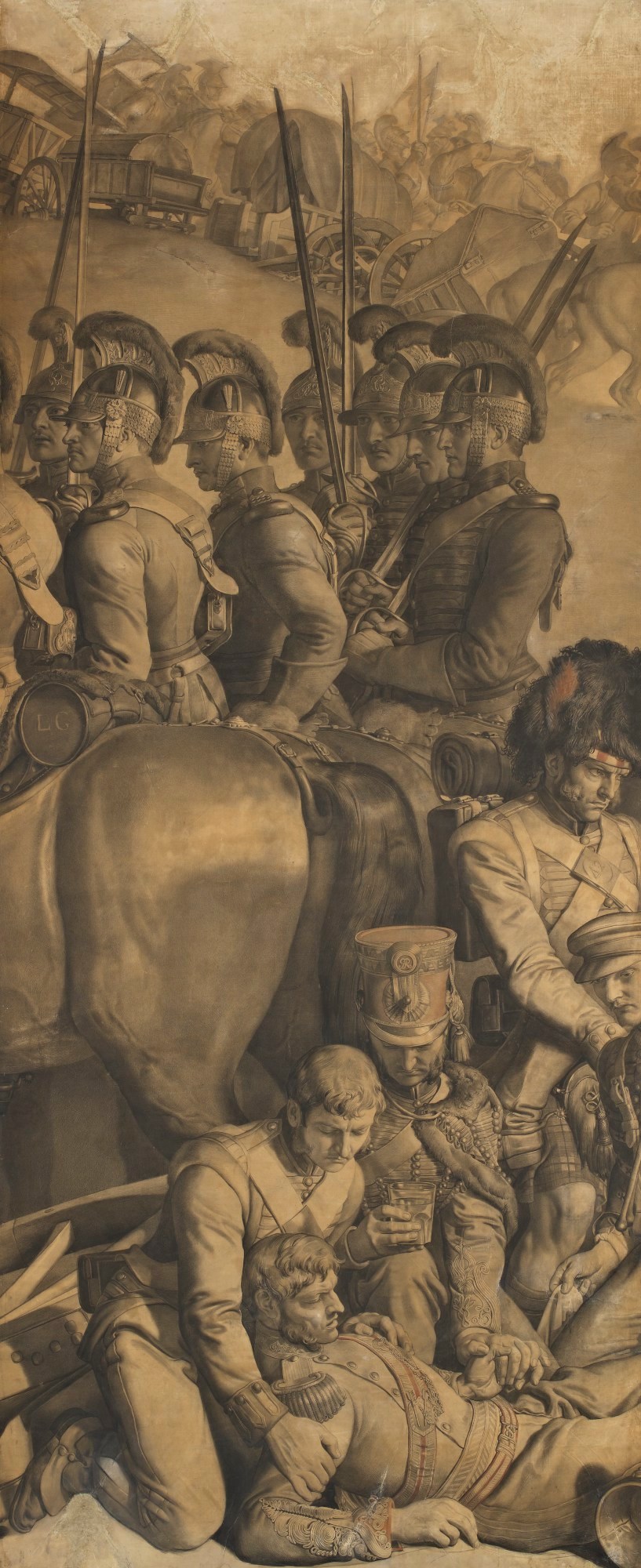
Daniel Maclise RA, Cartoon for 'The Meeting of Wellington and Blücher After the Battle of Waterloo', March 1858- June 1859.
Chalk on paper, on ten separate sheets attached to individual panels. 3372 mm x 13818 mm. © Photo: Royal Academy of Arts, London.
This image is not available to download. To licence this image for commercial purposes, contact our Picture Library at picturelibrary@royalacademy.org.uk
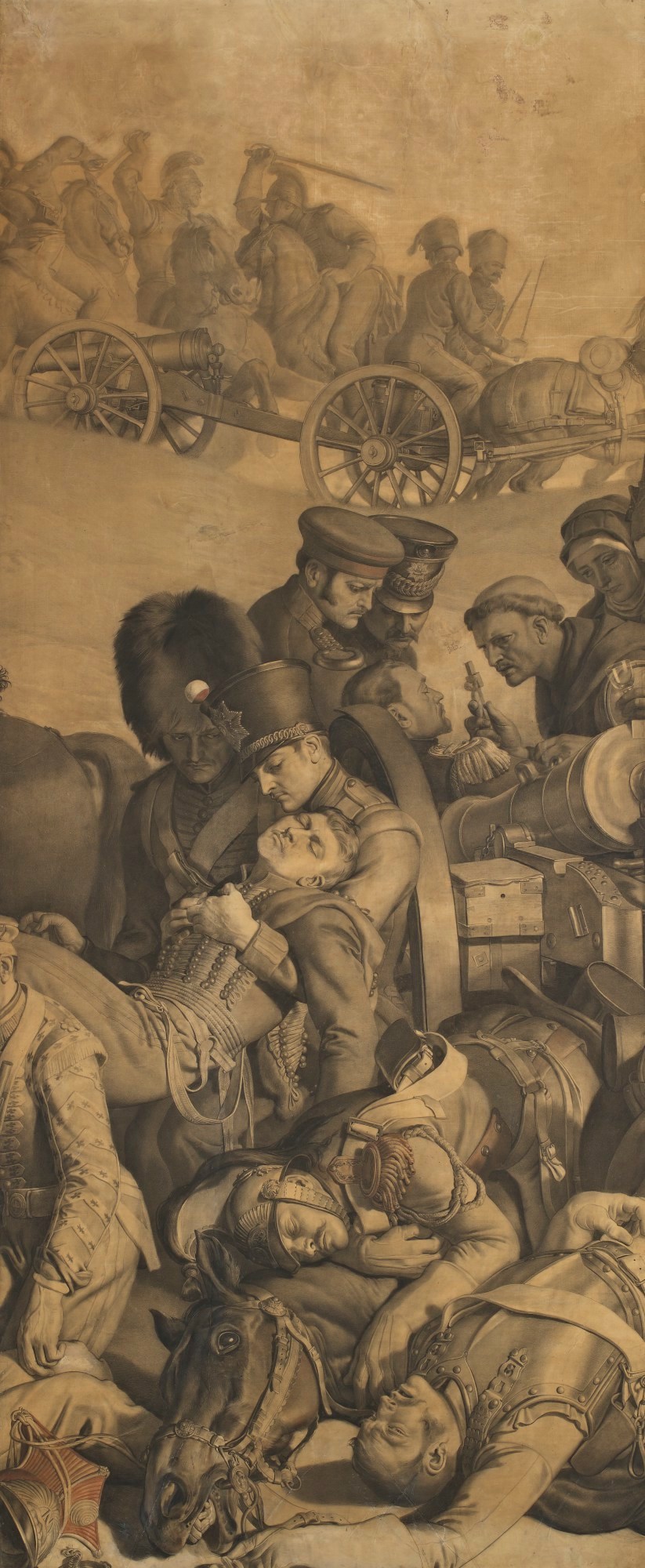
Daniel Maclise RA, Cartoon for 'The Meeting of Wellington and Blücher After the Battle of Waterloo', March 1858- June 1859.
Chalk on paper, on ten separate sheets attached to individual panels. 3372 mm x 13818 mm. © Photo: Royal Academy of Arts, London.
This image is not available to download. To licence this image for commercial purposes, contact our Picture Library at picturelibrary@royalacademy.org.uk
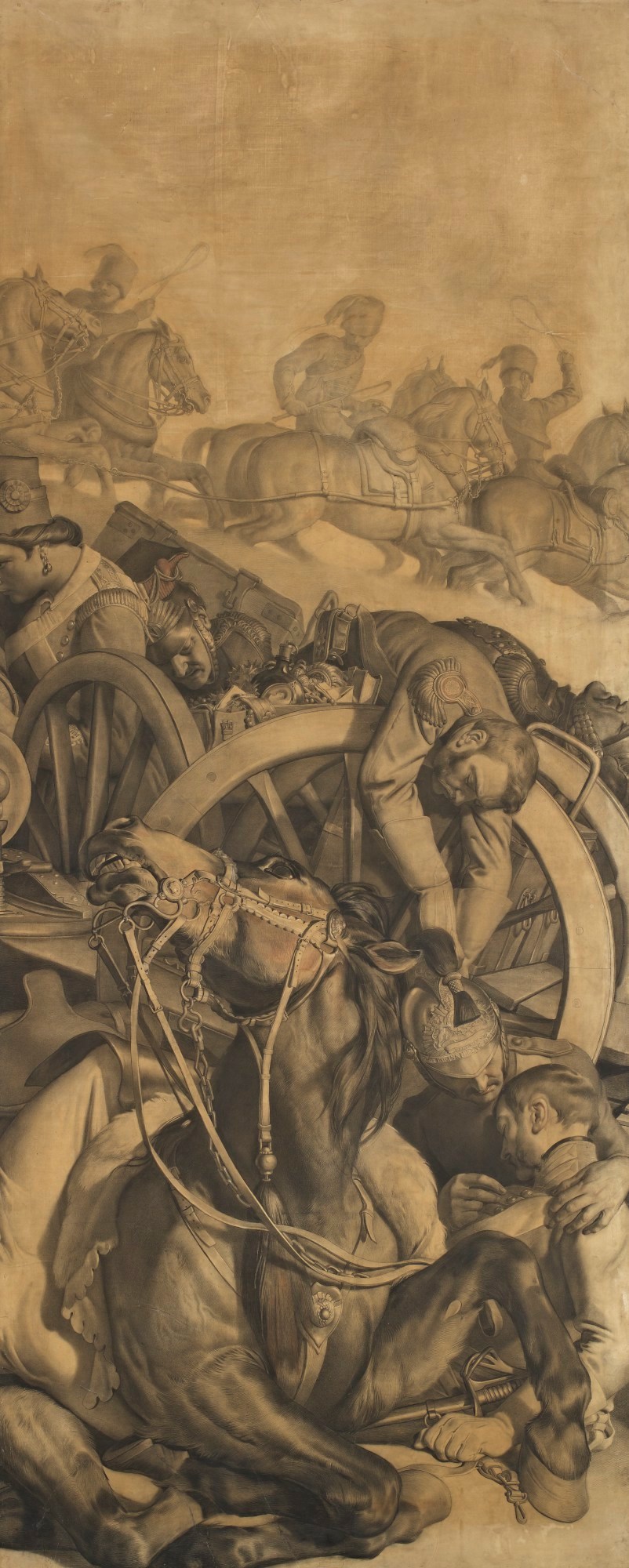
Daniel Maclise RA, Cartoon for 'The Meeting of Wellington and Blücher After the Battle of Waterloo', March 1858- June 1859.
Chalk on paper, on ten separate sheets attached to individual panels. 3372 mm x 13818 mm. © Photo: Royal Academy of Arts, London.
This image is not available to download. To licence this image for commercial purposes, contact our Picture Library at picturelibrary@royalacademy.org.uk

Daniel Maclise RA, Cartoon for 'The Meeting of Wellington and Blücher After the Battle of Waterloo', March 1858- June 1859.
Chalk on paper, on ten separate sheets attached to individual panels. 3372 mm x 13818 mm. © Photo: Royal Academy of Arts, London. Photographer: Prudence Cuming Associates Limited.
This image is not available to download. To licence this image for commercial purposes, contact our Picture Library at picturelibrary@royalacademy.org.uk
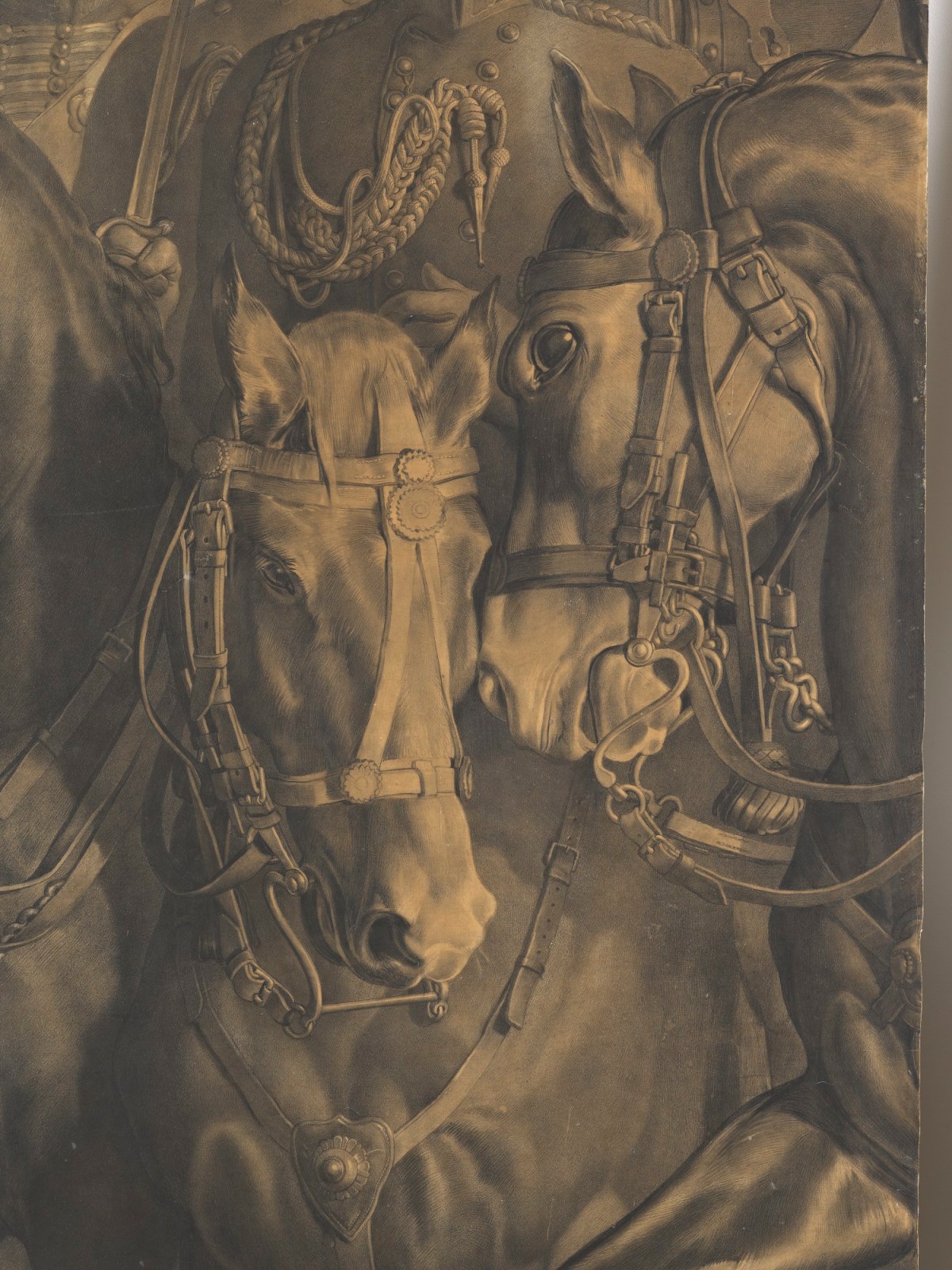
Daniel Maclise RA, Cartoon for 'The Meeting of Wellington and Blücher After the Battle of Waterloo', March 1858- June 1859.
Chalk on paper, on ten separate sheets attached to individual panels. 3372 mm x 13818 mm. © Photo: Royal Academy of Arts, London. Photographer: Prudence Cuming Associates Limited.
This image is not available to download. To licence this image for commercial purposes, contact our Picture Library at picturelibrary@royalacademy.org.uk
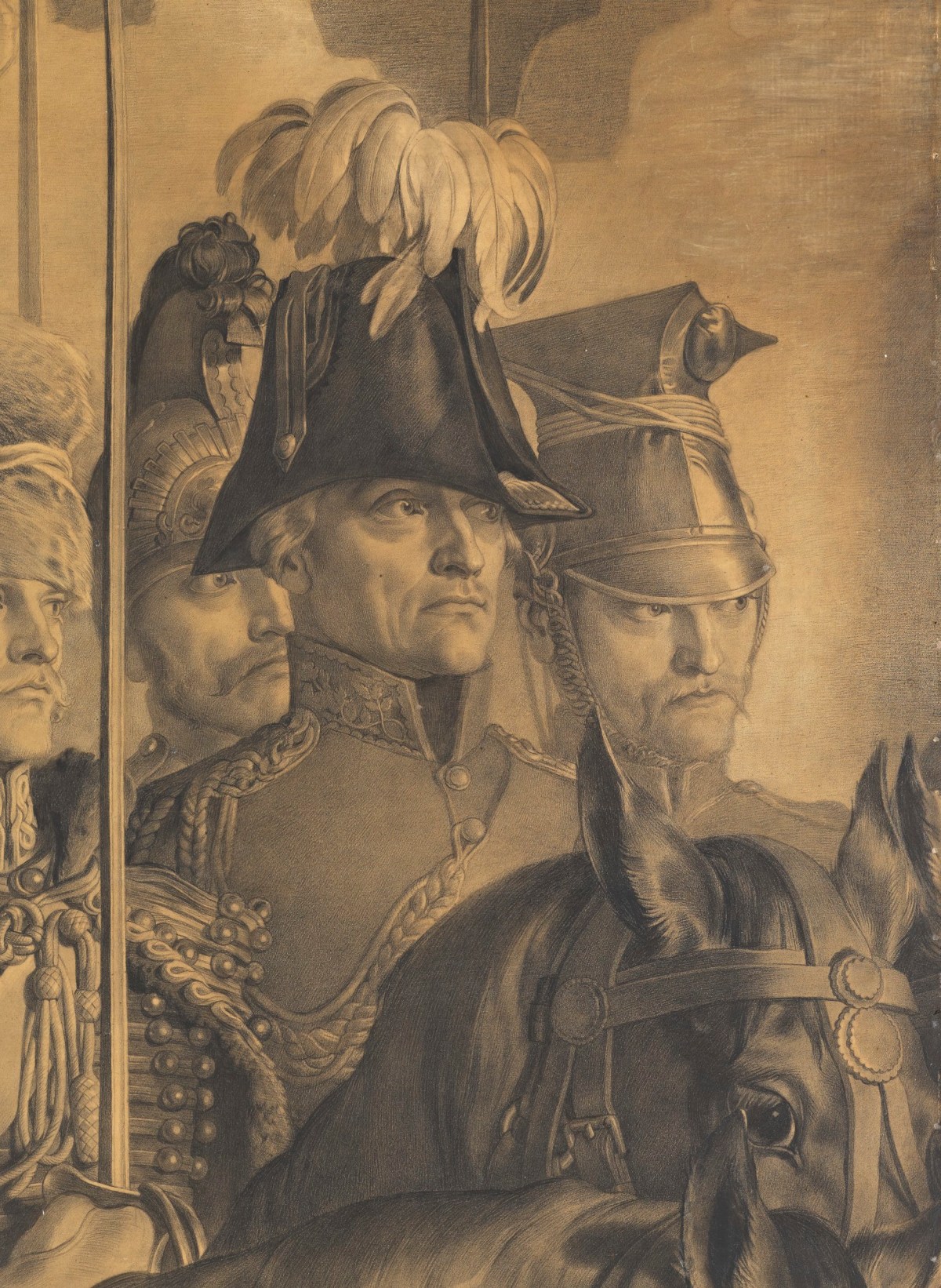
Daniel Maclise RA, Cartoon for 'The Meeting of Wellington and Blücher After the Battle of Waterloo', March 1858- June 1859.
Chalk on paper, on ten separate sheets attached to individual panels. 3372 mm x 13818 mm. © Photo: Royal Academy of Arts, London. Photographer: Prudence Cuming Associates Limited.
This image is not available to download. To licence this image for commercial purposes, contact our Picture Library at picturelibrary@royalacademy.org.uk
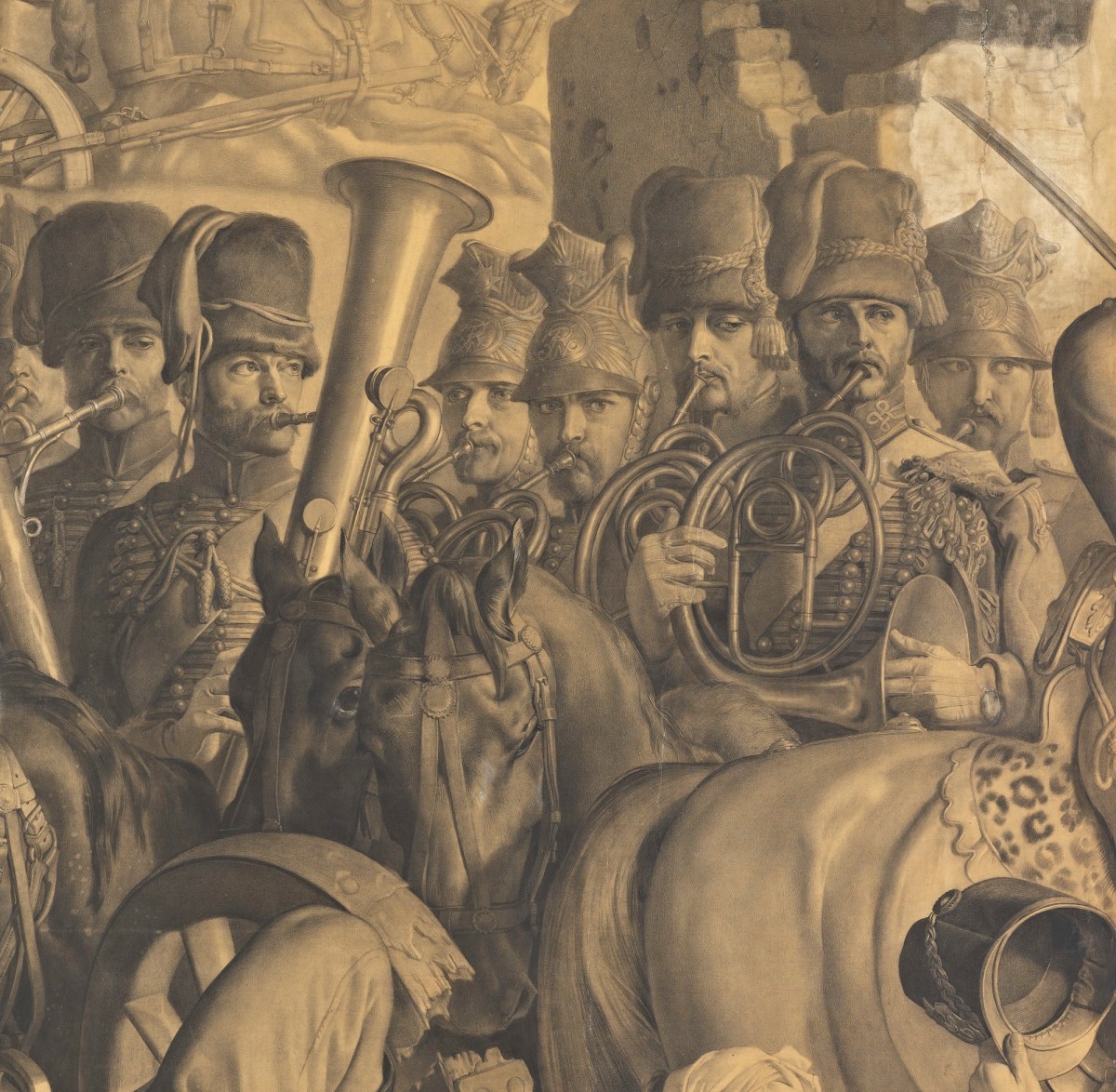
Daniel Maclise RA, Cartoon for 'The Meeting of Wellington and Blücher After the Battle of Waterloo', March 1858- June 1859.
Chalk on paper, on ten separate sheets attached to individual panels. 3372 mm x 13818 mm. © Photo: Royal Academy of Arts, London. Photographer: Prudence Cuming Associates Limited.
This image is not available to download. To licence this image for commercial purposes, contact our Picture Library at picturelibrary@royalacademy.org.uk
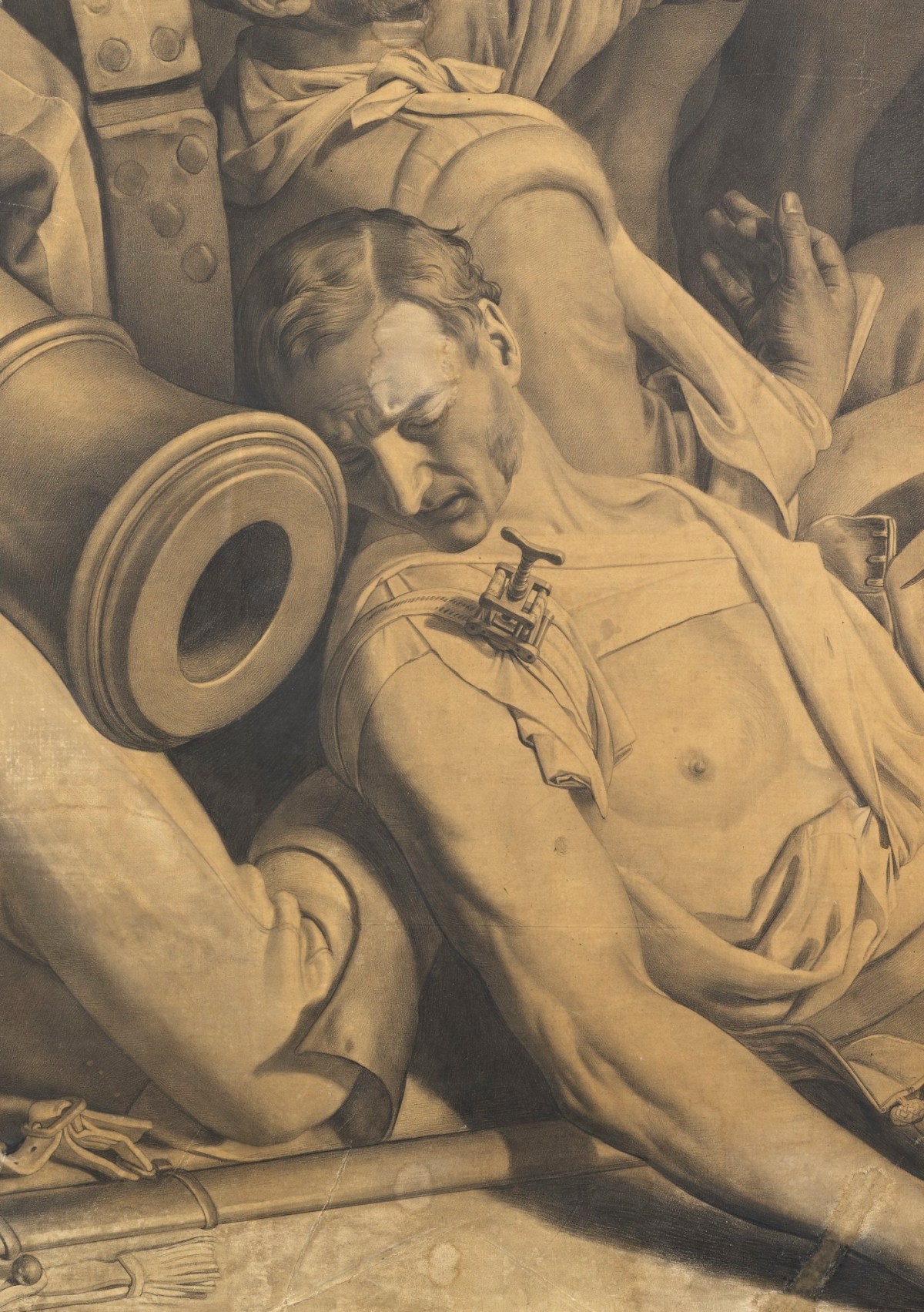
Daniel Maclise RA, Cartoon for 'The Meeting of Wellington and Blücher After the Battle of Waterloo', March 1858- June 1859.
Chalk on paper, on ten separate sheets attached to individual panels. 3372 mm x 13818 mm. © Photo: Royal Academy of Arts, London. Photographer: Prudence Cuming Associates Limited.
This image is not available to download. To licence this image for commercial purposes, contact our Picture Library at picturelibrary@royalacademy.org.uk

Daniel Maclise RA, Cartoon for 'The Meeting of Wellington and Blücher After the Battle of Waterloo', March 1858- June 1859.
Chalk on paper, on ten separate sheets attached to individual panels. 3372 mm x 13818 mm. © Photo: Royal Academy of Arts, London. Photographer: Prudence Cuming Associates Limited.
This image is not available to download. To licence this image for commercial purposes, contact our Picture Library at picturelibrary@royalacademy.org.uk
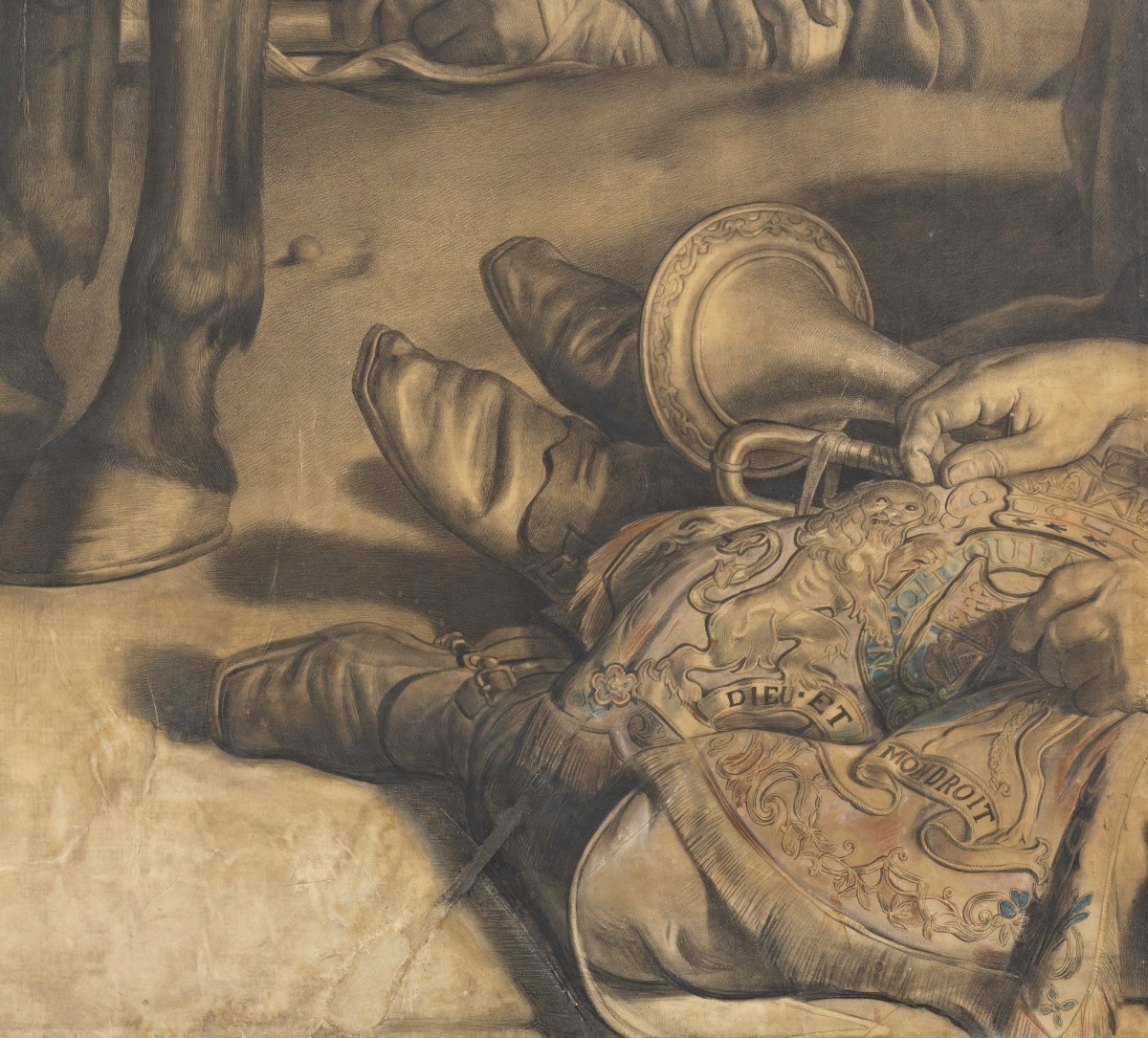
Daniel Maclise RA, Cartoon for 'The Meeting of Wellington and Blücher After the Battle of Waterloo', March 1858- June 1859.
Chalk on paper, on ten separate sheets attached to individual panels. 3372 mm x 13818 mm. © Photo: Royal Academy of Arts, London. Photographer: Prudence Cuming Associates Limited.
This image is not available to download. To licence this image for commercial purposes, contact our Picture Library at picturelibrary@royalacademy.org.uk

Daniel Maclise RA, Cartoon for 'The Meeting of Wellington and Blücher After the Battle of Waterloo', March 1858- June 1859.
Chalk on paper, on ten separate sheets attached to individual panels. 3372 mm x 13818 mm. © Photo: Royal Academy of Arts, London. Photographer: Prudence Cuming Associates Limited.
This image is not available to download. To licence this image for commercial purposes, contact our Picture Library at picturelibrary@royalacademy.org.uk
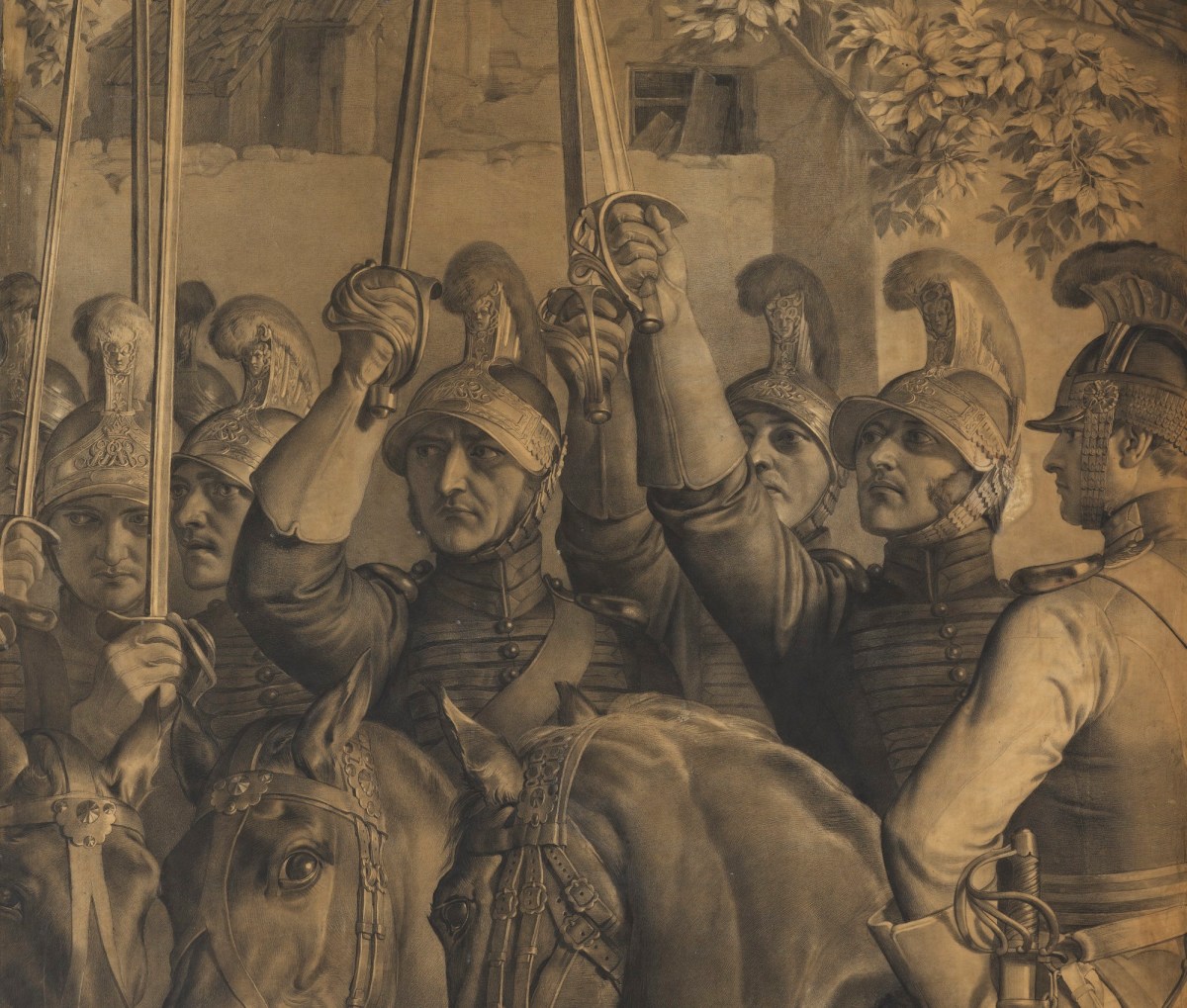
Daniel Maclise RA, Cartoon for 'The Meeting of Wellington and Blücher After the Battle of Waterloo', March 1858- June 1859.
Chalk on paper, on ten separate sheets attached to individual panels. 3372 mm x 13818 mm. © Photo: Royal Academy of Arts, London. Photographer: Prudence Cuming Associates Limited.
This image is not available to download. To licence this image for commercial purposes, contact our Picture Library at picturelibrary@royalacademy.org.uk
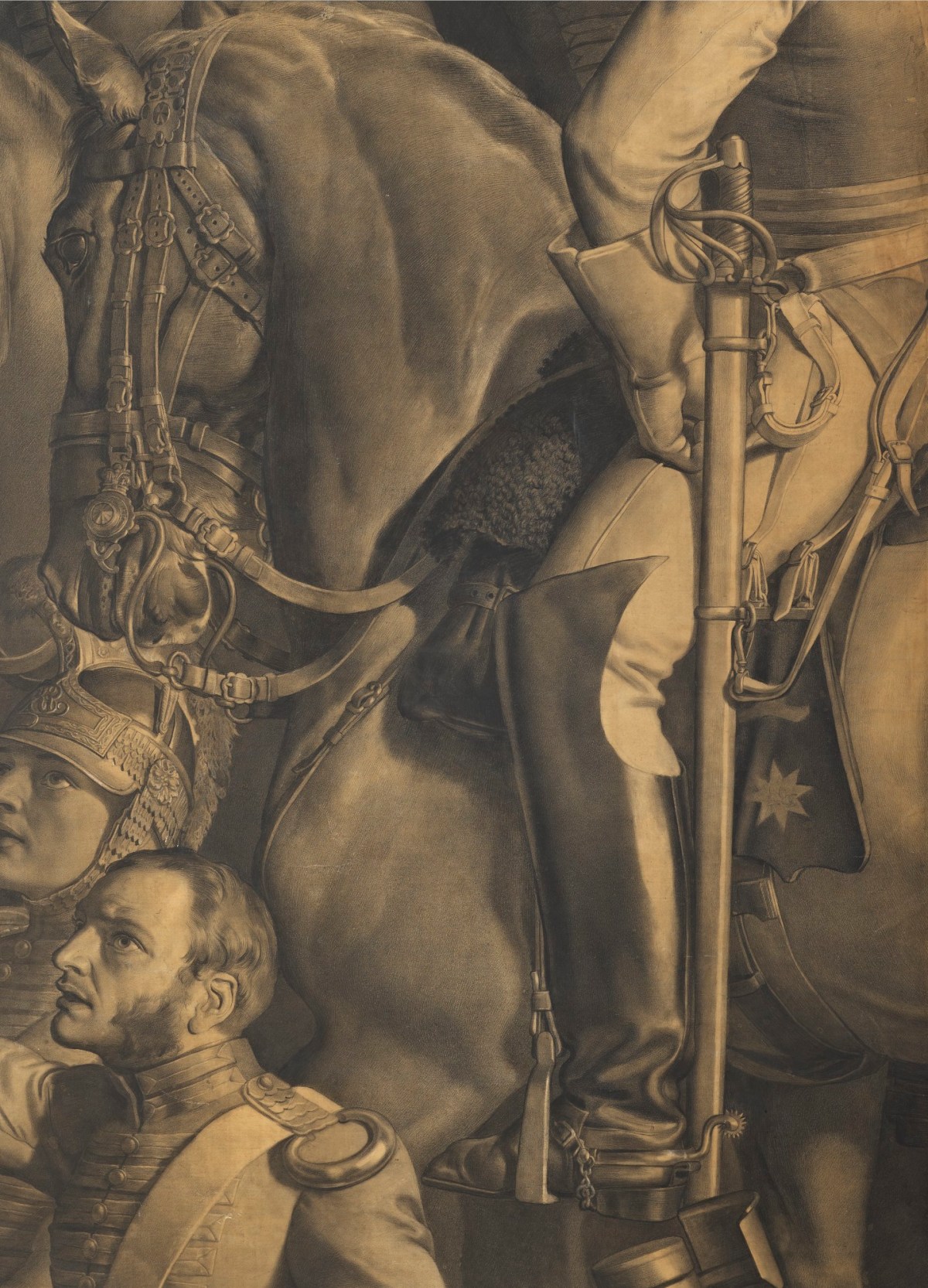
Daniel Maclise RA, Cartoon for 'The Meeting of Wellington and Blücher After the Battle of Waterloo', March 1858- June 1859.
Chalk on paper, on ten separate sheets attached to individual panels. 3372 mm x 13818 mm. © Photo: Royal Academy of Arts, London. Photographer: Prudence Cuming Associates Limited.
This image is not available to download. To licence this image for commercial purposes, contact our Picture Library at picturelibrary@royalacademy.org.uk
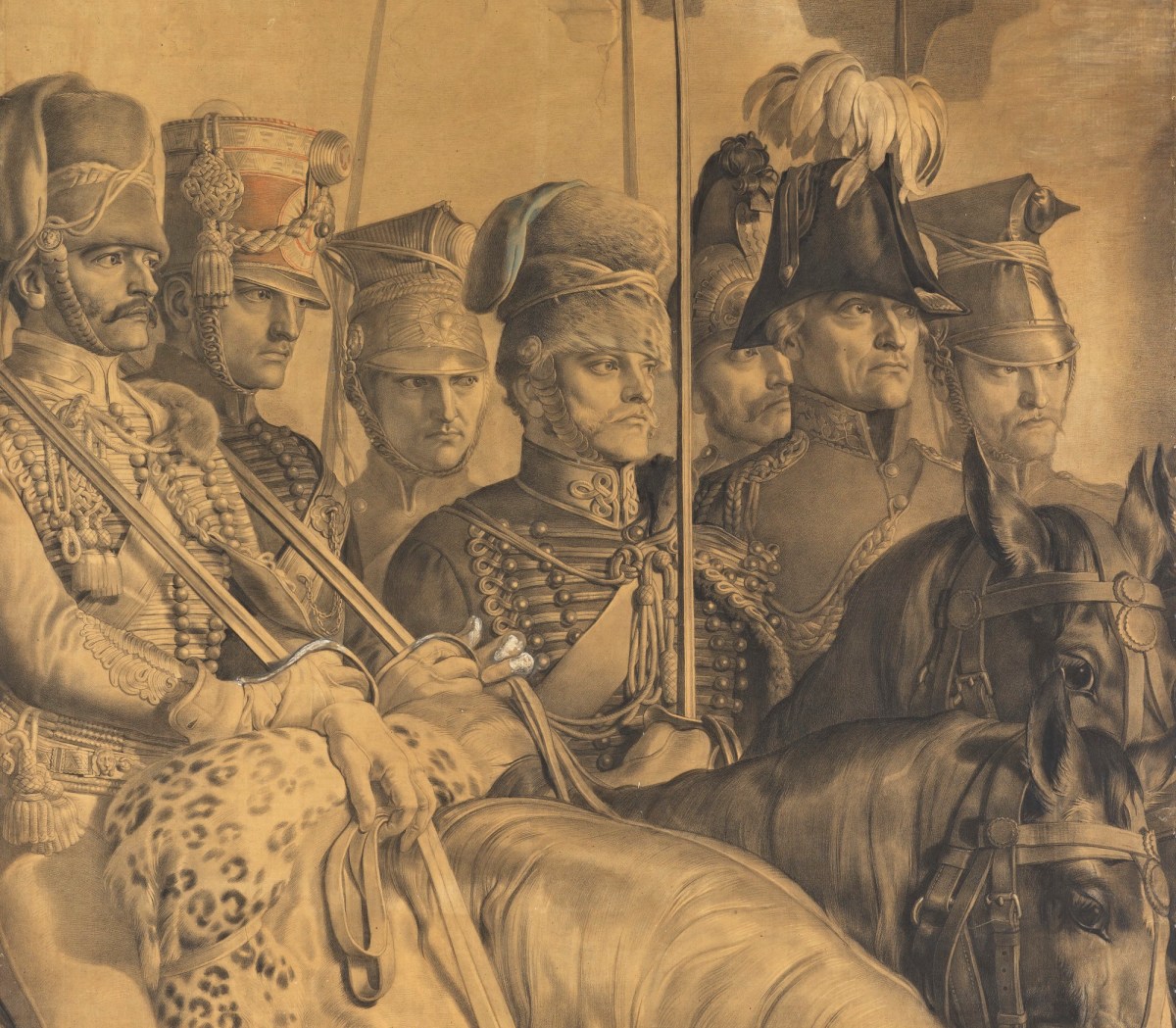
Daniel Maclise RA, Cartoon for 'The Meeting of Wellington and Blücher After the Battle of Waterloo', March 1858- June 1859.
Chalk on paper, on ten separate sheets attached to individual panels. 3372 mm x 13818 mm. © Photo: Royal Academy of Arts, London. Photographer: Prudence Cuming Associates Limited.
This image is not available to download. To licence this image for commercial purposes, contact our Picture Library at picturelibrary@royalacademy.org.uk
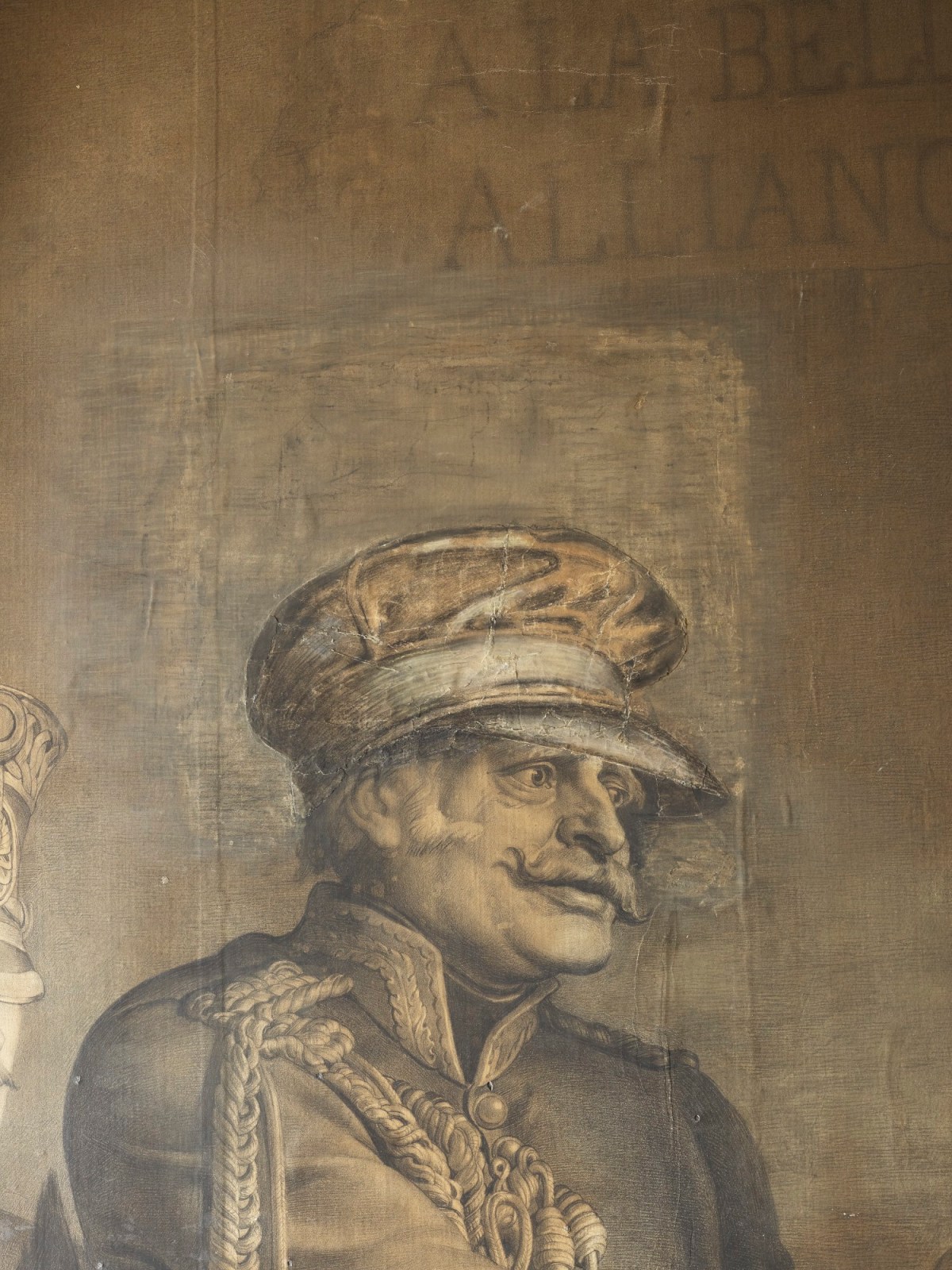
Daniel Maclise RA, Cartoon for 'The Meeting of Wellington and Blücher After the Battle of Waterloo', March 1858- June 1859.
Chalk on paper, on ten separate sheets attached to individual panels. 3372 mm x 13818 mm. © Photo: Royal Academy of Arts, London. Photographer: Prudence Cuming Associates Limited.
This image is not available to download. To licence this image for commercial purposes, contact our Picture Library at picturelibrary@royalacademy.org.uk
Cartoon for 'The Meeting of Wellington and Blücher After the Battle of Waterloo', March 1858- June 1859
Daniel Maclise RA (1806 - 1870)
RA Collection: Art
This drawing is Maclise's 'cartoon' (a full-scale preparatory drawing) for his fresco in the Royal Gallery, Palace of Westminster, depicting the meeting of the Duke of Wellington and General Blücher at the end of the Battle of Waterloo on 18 June 1815. They are shown shaking hands outside the ruins of Napoleon's headquarters at the inn 'La Belle Alliance'. As the famous battle was still in living memory, Maclise went to great lengths to provide a plausible depiction of the personnel who were present on the day and was assisted in his research by Sir Charles Eastlake who wrote to General Nostitz, Blücher's former aide-de-camp, for information. The War Office, and even Queen Victoria and Prince Albert, also became involved in the effort to verify accounts of the meeting between the two generals and to provide details of the correct uniforms and equipment of their troops.
Although celebrating a British victory, Maclise's grand composition presents a grim scene of the aftermath of the battle with dead and wounded figures dominating the foreground. James Dafforne, writing after Maclise’s death in 1872, described it as ‘at once the most faithful and the most modest of all the battle-subjects we have ever seen’, noting how the artist dealt ‘tenderly’ with the challenge of depicting the defeated troops of Napoleon to create a memorial of a great victory that was ‘without the flush of conquest’.
Maclise made a particular effort to represent troops from the different regiments involved, including Prussians, French, Flemish, English, Scots and Irish soldiers. Although some of these troops were unlikely to have been found around the area of La Belle Alliance,Maclise's intention was, presumably, to give a sense of the range of personnel involved in the battle of Waterloo. He spent a considerable amount of time researching the different regimental uniforms and based some of the drawing on items actually worn on the battlefield of Waterloo. Maclise originally depicted Blücher wearing a cocked hat with feathers but, after being informed by Nostitz that the General had in fact worn a 'forage cap', this part of the cartoon was changed, as can be clearly seen on the cartoon. Maclise wrote that 'having wafered a piece of paper over Blucher's cocked hat and feathers, I contrived to draw the forage cap'. Despite his efforts, however, it has been found that some of the equipment is incorrect. Curators from the Royal Armouries identified the swords brandished by the British are in fact based on French examples.
When the cartoon was hung in the Royal Gallery at the Palace of Westminster in 1859 contemporary critics were impressed by the combination of its monumental scale (it is around 45 feet in width) and Maclise's consistent and precise draughtsmanship. Maclise described himself as a 'Cockneyfied Corkonian', brought up in Cork, Ireland, but having lived in London since 1827. Although he had trained both in Cork and at the Royal Academy Schools, his technical mastery, as displayed in the Wellington and Blücher cartoon, was interpreted by his contemporaries as a matter of English national pride. The Art Journal enthused that 'this is the greatest work of its class that has been produced in England: nor is there any painter of the Continent who has surpassed it - not even Kaulbach: assuredly no other'. At this time Maclise also received a gold porte-crayon and a letter of congratulation signed by 43 of his fellow artists.
According to Maclise's early biographer, W. Justin O'Driscoll, the artist began work on the cartoon in March 1858. Due to the colossal size of the picture, he had to divide the cartoon into ten panels so that he could work on each one separately in his drawing room at Russell Place. However, O'Driscoll states that they were then 'skilfully joined together' so as to present 'an unbroken surface'. The artist had no assistance and completed the drawing in just over a year. Very shortly after finishing the cartoon, he began work on the fresco in the Royal Gallery. However, he quickly found that the minutely detailed cartoon was extremely difficult to translate into slow-drying fresco and decided to resign the commission. Prince Albert suggested that instead of giving up, Maclise should visit Germany to study the new 'stereochrome' or 'waterglass' technique that had been developed there which emulated the appearance of fresco painting while allowing the artist to change and retouch the work. Maclise agreed and after visiting Berlin, Munich and Dresden he decided to use the stereochrome process. This technique, though more suited to the task and to the English climate, proved not to be as effective as originally hoped. Both of Maclise's frescoes in the Royal Gallery faded rapidly and were thought to have been ruined within a matter of decades. However, the findings of a recent conservation project at the Royal Gallery suggest that the frescoes are in better condition than previously thought.
The cartoon was purchased by the Royal Academy at auction after Maclise's death in 1870. An article in the press reported 'great applause' following the announcement that it had been purchased by the RA ( Morning Post, 27 June 1870). The institution paid 300 guineas which was not a huge price for a work of this scale but still a considerable amount for a drawing. For comparison, Rossetti's 'Beata Beatrix' was worth 300 guineas when it was painted in 1864 and Whistler's notorious 'Nocturne in Black and Gold: The Falling Rocket' was for sale for 200 guineas in 1877. In his 1872 biography of Maclise, W. J. O'Driscoll mentioned the Academy's acquisition of the cartoon, stating that 'no more graceful tribute of regard could have been offered to his memory, no stronger proof of admiration of his genius, than the purchase - by the President and Council of the Royal Academy - of the magnificent cartoon of 'Wellington and Blücher'. It occupies a prominent place in one of their ateliers, and will serve as an exemplar to students of the consummate mastery of one who had preceded them in the curriculum which that institution provides'.
The cartoon was soon put on display to the public in the Academy's Gibson and Diploma galleries. However, after the First World War, several Academicians complained that it was taking up too much space and there were attempts to have it removed from the galleries. The cartoon was lent to Sandhurst Military College between 1928 and 1935 and was subsequently put into storage, where it has remained ever since apart from its inclusion in the National Portrait Gallery's exhibition on Daniel Maclise in 1972.
Read about this work on the RA blog: https://www.royalacademy.org.uk/articles/tag/daniel-maclise
Click on the following link to find out more about this remarkable work and to explore some of the stories, details and secrets hidden within the work as revealed by our curators and conservators. Explore the cartoon
Object details
3372 mm x 13818 mm
Start exploring the RA Collection
- Explore art works, paint-smeared palettes, scribbled letters and more...
- Artists and architects have run the RA for 250 years.
Our Collection is a record of them.
